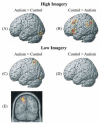Sentence comprehension in autism: thinking in pictures with decreased functional connectivity
- PMID: 16835247
- PMCID: PMC4500127
- DOI: 10.1093/brain/awl164
Sentence comprehension in autism: thinking in pictures with decreased functional connectivity
Abstract
Comprehending high-imagery sentences like The number eight when rotated 90 degrees looks like a pair of eyeglasses involves the participation and integration of several cortical regions. The linguistic content must be processed to determine what is to be mentally imaged, and then the mental image must be evaluated and related to the sentence. A theory of cortical underconnectivity in autism predicts that the interregional collaboration required between linguistic and imaginal processing in this task would be underserved in autism. This functional MRI study examined brain activation in 12 participants with autism and 13 age- and IQ-matched control participants while they processed sentences with either high- or low-imagery content. The analysis of functional connectivity among cortical regions showed that the language and spatial centres in the participants with autism were not as well synchronized as in controls. In addition to the functional connectivity differences, there was also a group difference in activation. In the processing of low-imagery sentences (e.g. Addition, subtraction and multiplication are all math skills), the use of imagery is not essential to comprehension. Nevertheless, the autism group activated parietal and occipital brain regions associated with imagery for comprehending both the low and high-imagery sentences, suggesting that they were using mental imagery in both conditions. In contrast, the control group showed imagery-related activation primarily in the high-imagery condition. The findings provide further evidence of underintegration of language and imagery in autism (and hence expand the understanding of underconnectivity) but also show that people with autism are more reliant on visualization to support language comprehension.
Figures


References
-
- Alivisatos B, Petrides M. Functional activation of the human brain during mental rotation. Neuropsychologia. 1997;35:111–8. - PubMed
-
- Awh E, Jonides J, Smith EE, Schumacher EH, Koeppe RA, Katz S. Dissociation of storage and rehearsal in verbal working memory: evidence from positron emission tomography. Psychol Sci. 1996;7:25–31.
-
- Bertone A, Faubert J. Motion sensitivity of first and second-order translating, expanding/contracting and rotation patterns. Invest Ophthalmol Vis Sci. 1999;40:2245.
-
- Bertone A, Faubert J. How is complex second-order motion processed? Vision Res. 2003;43:2591–601. - PubMed
-
- Bertone A, Mottron L, Jelenic P, Faubert J. Enhanced and diminished visuospatial information processing in autism depends on stimulus complexity. Brain. 2005;128:2430–41. - PubMed

